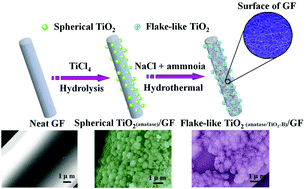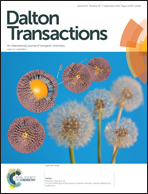Controlled synthesis of hierarchical TiO2 nanoparticles on glass fibres and their photocatalytic performance
Abstract
This paper reports the synthesis of novel photocatalysts consisting of TiO2 nanoparticles and glass fibres (GF) using a two-step process. The method involves the hydrolysis of titanium tetrachloride in the presence of GF and a following hydrothermal process under alkaline conditions. Various techniques are employed to characterize the morphology, structure and crystallinity of TiO2 on the fibre surface. The results show that depending on the experiment setups, TiO2 nanoparticles exhibit spherical or flake-like morphology, forming characteristic hierarchical structures along with flexible GF. Flake-like TiO2/GF exhibits much enhanced photocatalytic activity thanks to the large surface area and the hetero-junction of anatase and TiO2-B phases observed in its structure. An interesting observation is that the alkali treatment of GF leads to the formation of porous structures on the fibre surface, facilitating the adsorption–concentration-promoted photocatalytic process. The removal ratio of the organic dye by employing TiO2/GF remains more than 80% after six cyclic runs, showing the reusability of photocatalysts in real application. The novelty of this work lies in the synergy arising from materials with unique morphologies, structures and availabilities as well as capabilities in separating photogenerated electron–hole pairs, which have not been specifically considered previously in photocatalytic semiconductors.


 Please wait while we load your content...
Please wait while we load your content...